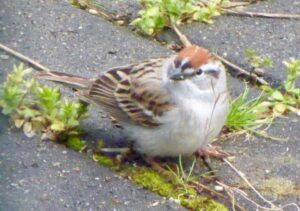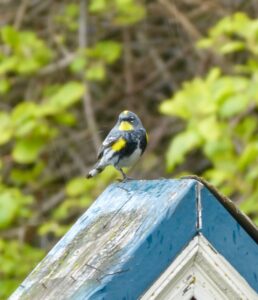 You don’t have to be any good at birding to like birding. With birds you get beauty, comedy, and a lesson in paying attention, and even a tiny bird can drive the headlines right out of your head.
You don’t have to be any good at birding to like birding. With birds you get beauty, comedy, and a lesson in paying attention, and even a tiny bird can drive the headlines right out of your head.
I, to take an example, am not good at it. But it occurs to me I’m getting better.
The two main reasons I’m not good at it are my eyesight and my Magic-Erase memory. If I get any more nearsighted my eyeballs are going to flatten out like throat lozenges. And this morning I aimed my Merlin Song ID app at what turned out to be a Bewick’s wren for the fourth morning in a row. I’ll do it tomorrow too.
Nevertheless some information seems to have burrowed into the brain-hole often enough to get gummy and stick. I can prove it by my shiny new Chipping Sparrow. Ain’t it purty? It was hopping along our patio. I took a photo of it and hauled out my field guide and had it narrowed down to chipping sparrow with a backup juvenile white-crowned just in case. And I flang it on the internet, where my birder buddies quickly confirmed my bird.
In the field guide the range appears to be every the hell where, and the description is disparaging at best: “common” and “widespread.” I’m sorry, but fat-shaming a bird says more about you than about the bird. Plus, if it was so dang common, why hadn’t I noticed it?
But then the congratulations rolled in, and the suggestions that it was a pretty good find for my particular area, and maybe just bopped through a few times a year, and I felt better about myself. Also, it occurred to me that the very fact I photographed it shows I have learned some things. For most people (non-birder division) this sparrow would have registered as another Little Brown Job. But somehow I knew it was different. I did the same thing with a Purple Finch a while back. Clearly, I have at least learned some of the birds that this one was Not. Yay!
I garden on a double lot in the middle of the city. It’s not the worst bird city and there are all sorts of cool species in the copious Doug Fir remnants of our original forests. And sometimes it seems like bald eagles are thick as pigeons around here. But my back yard is sort of a starter yard for birding. Baby’s First Aviary. There are going to be about fifteen regulars I’m likely to see and that leaves a lot left over to stand out, should they ever show up.
 My friends Sara and Kelly also have a back yard in the middle of a city (Toronto counts as a city even though it’s across the official dotted line) and it’s actually a very diminutive back yard but there are so many species in it that their feathers are rubbing off just trying to sidle past each other. Their back yard is a major stop on the Atlantic Flyway and mine isn’t. You stand under the Atlantic Flyway and warblers will rattle across the sky all day and all night like God’s confetti.
My friends Sara and Kelly also have a back yard in the middle of a city (Toronto counts as a city even though it’s across the official dotted line) and it’s actually a very diminutive back yard but there are so many species in it that their feathers are rubbing off just trying to sidle past each other. Their back yard is a major stop on the Atlantic Flyway and mine isn’t. You stand under the Atlantic Flyway and warblers will rattle across the sky all day and all night like God’s confetti.
Meanwhile, the Pacific Flyway might occasionally poot out any of four warblers in my yard. I have to go somewhere else to find more.
Don’t think I won’t. The headlines alone will drive me out.
We live very close to an urban area, but have a big yard. A while back, I had it designated a Backyard Wildlife Refuge by the National Wildlife Federation. I have a sign from them in my front yard to show people “Hey, it’s messy on purpose.” All a person needs is to draw up a diagram of their yard, indicating where there are trees, shrubs, plants, birdhouses, birdbaths or ponds, feeders, and stuff like that. I notice a lot more people around here — even in the city — doing this. Most of them just have it in their backyard, but I have it front and back. No lawn. Lots of trees. Fish pond in the back that attracts frogs now and again. Not only do we get a lot of birds, but animals of all sorts wander through. It’s not only a wildlife refuge, but a refuge for me from this crazy world.
We’ve got a big program for that here too. Mine isn’t certified but I haven’t tried. I do have a lot of non-native plants but also natives. I’m not sure I’m up to the correct percentage native…but I think so!
I used to try for mostly native, but unfortunately, birds poop out seeds from invasives — and we have a lot of birds. Hence, many invasives, like honeysuckle, cleavers, some poison ivy, and many “tree fetuses” that are either too close to the house, other trees, or under the power lines. These I must laboriously pull by hand or clip, because I will NOT use Round-Up.
Last summer, we were sitting out on our patio when we saw a brilliant little yellow bird with a black mask hopping about under a shrub. A gorgeous little bird we said we had never seen before in our lives. Turned out it was a Common Yellowthroat.
I wonder why we never saw it before, since it is “common” and also yellow and black, and therefore noticeable.
“The common yellowthroat is a New World warbler. In the U.S. Midwest, it is also known as the yellow bandit. It is an abundant breeder in North America, ranging from southern Canada to central Mexico.”
Hello, you! Were you under the shrubs the whole time?!?
That’s a pretty bird. I’ve never seen one in my yard but they’re common especially in the low growth around wetlands. This year even our yard might be a wetland…which is GOOD!
So, is that lil one on the blue roof a yellow-rumped warbler? Can’t see its’ rump to be sure….
Yup, that’s my butterbutt!
Murr, I love that you enjoy birding. Hell, you are even named after a “common” bird – the Common Murre. Well, I guess you are missing an “e”. But close enough. I hope you will consider contacting your friend Sarah S. Who runs the Birdathon program for Portland Audubon and do a day trip with her. You would love it.
I would totally have put the E on my name if I’d heard of the bird fifty years ago when Mary sludged into Murr. Some of my friends put it on there anyway! Sarah Swanson invited me to her birdathon group gosh, ten years ago? Because it was The Murre The Merrier. I think I’ve done about six trips with her and Max. She’s sharp as hell.
I’m still at the bird stage of birding—wow, there’s a cool looking bird! I have binoculars that are mostly trained on the local meth addicted car thieves across the street. One thing is certain, the songs are varied and fill the ear waves, especially on days when I-5 seems to quiet down.
This would make an awesome first paragraph to a crime novel!
The bird stage of birding is a genuine stage. You’re on the path!
Oh Murr. In my Uni Creative Writing class I learned that poetry has vivid images, compression and a third thing I can’t remember, it being so long ago and all, but that line; “You stand under the Atlantic Flyway and warblers will rattle across the sky all day and all night like God’s confetti.” is undeniably some of the best poetry I’ve read in a good while. <3
I’ll second that!
Well gosh! Thanks!
Merlin Bird ID seems to tell me that every song is a Bewick’s Wren (or a scrub jay)! So either it’s crazy, or those wrens have quite a repertoire…
I am having the exact same experience. I swear they’re not the same song. The other day I pointed my phone at it and it said Pine Warbler and I got all excited because I KNEW that was a life bird, and it was right in my yard! Later I tried to replay that recording and it had erased “Pine Warbler” and put in Bewick’s wren. Hell, if Merlin doesn’t know, I shouldn’t feel too bad. Perhaps Merlin did a little research and discovered Pine Warbler wasn’t within a thousand miles of here.
You said flang.
Don’t think I don’t know who you are, darlin’.
I hope you’re not seriously considering leaving the Pacific Northwest. I take great comfort from the fact that that you’re writing from my hometown. I’m 83 and thankful I don’t have any grandkids. Sad world.